Chhattisgarh – Culture and Tradition
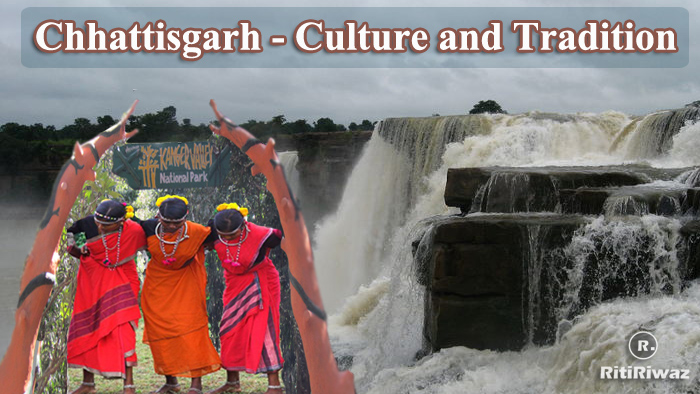
Chhattisgarh located in the center-east and is one of the 28 states of India. The state was formed on 1st November 2000 by partitioning ten Chhattisgarhi and six Gondi speaking districts of Madhya Pradesh. This state is the 10th largest state in the country, with the population making it the 17th most populous state in India. Chhattisgarh borders Madhya Pradesh in the northwest, Uttar Pradesh in the north, Jharkhand in the northeast, Maharashtra in the southwest, Telangana and Andhra Pradesh in the south, and Odisha in the southeast.
Chhattisgarh northern and southern portion is hilly, while the central portion has a fertile belt of plains. The state plateaus are streaked with high range of Satpuras in the north, the river Mahanadi and its tributaries in the Central plains and the Bastar Plateau in the South. The Pats (Hills) give rise to the main river systems Mahanadi, Hasdeo, Shivnath, and Indravati.
Chhattisgarh literally means “Thirty-Six forts” and it has 36 demesnes (feudal territories) under it. The Capital of the state if Raipur and is one of the fastest-developing states in India. In terms of mineral revenue, it is the second-largest state in the country. The state is a source of electricity and steel for our country as well as a large contributor to coal. Chhattisgarh is the only tin producing State in India (in Bastar district). Twenty-Eight known varieties of minerals are found in the State including precious stones & diamonds, iron ore, coal, limestone, dolomite, tin ore, bauxite, and gold. The State has a high potential for mining good quality of diamonds.
The state is called a rice bowl because of the rich paddy crop. The fertile soil of the state yields various products like wood, spices, honey, wax and tamarind, Copper ore, limestone, coal, and phosphate. Chhattisgarh with its diverse folk culture is known for stunning waterfalls, beautiful landscapes, caves, temples, heritage sites.
History

Chhattisgarh was carved out from Madhya Pradesh on 1st November 2000 by including 16 Chhattisgarhi speaking southeastern districts. It got its name from the 36 ancient forts in the area which are Ratanpur, Vijaypur, Kharound, Maro, Kautgarh, Nawagarh, Sondhi, Aukhar, Padarbhatta, Semriya, Champa, Lafa, Chhuri, Kenda, Matin, Aparora, Pendra, Kurkuti-kandri, Raipur, Patan, Simaga, Singarpur, Lavan, Omera, Durg, Saradha, Sirasa, Menhadi, Khallari, Sirpur, Figeswar, Rajim, Singhangarh, Suvarmar, Tenganagarh, and Akaltara. However, some believe that the name Chhattisgarh is the corrupted form of Chedisgarh which literally means Raj or “Empire of the chedis“.
In ancient times this area was known as Dakshin Kosla (Southern Kosal). Sharabhapuri, Panduwanshi, Somvanshi, Kalachuri, and Nagavanshi rulers ruled the region between the 6th and 12th centuries. In the 11th century, the Bastar region of Chhattisgarh was invaded by Rajendra Chola I and Kulothunga Chola I of the Chola Empire.
From 1741 to 1845, Chhattisgarh was under the control of the Maratha Empire. From 1845 to 1947, the British had control over Chhattisgarh. With the arrival of the British in 1845, Raipur gained prominence at the place of Ratanpur. In 1905 Sambalpur district was shifted to Odisha and Surguja State was shifted from Bengal to Chhattisgarh.

The new state was established on 1 November 1956 by merging the new area into the region and later it remained part of the state for 44 years of independence. Before becoming the new state of Madhya Pradesh, this region was part of the ancient Madhya Pradesh state, whose capital was also Bhopal. Prior to this, the region was part of the Central Provinces and Berar under the British Raj. Some areas of Chhattisgarh state used to be concentrated provinces at the time of British rule, but they were later included in Madhya Pradesh.
The first independent state was demanded in 1920. After this, this demand kept happening again and again in a short span of time, but no campaign was ever established for it. All political parties always came together, there were social meetings, seminars, rallies, and strikes. In 1924, Raipur Congress Unit demanded an independent state and this was also discussed in the annual meeting of the Indian Congress in Tripura. The bar to establish a regional Congress organization in Chhattisgarh was also discussed.
When the State Reorganization Commission was set up in 1954, the demand for an independent Chhattisgarh state was brought to the fore, but the matter was still not approved. In 1955, there was a demand for an independent state in the Nagpur assembly, which at that time was in central India.
The protest also saw more activities in 1990. This included the establishment of a political forum in the state and in particular the establishment of a state building forum. Chandulal Chandrakar led the forum and many successful regional movements were organized in the forum. These movements of the Forum were getting support from all the organizations, including the Bharatiya Janata Party and the Indian National Congress.
The new National Democratic Alliance (NDA) government sent the reconstituted Chhattisgarh Beel to Madhya Pradesh Assembly for approval, where it was once again unanimously approved and introduced in the Lok Sabha. The bill of independent Chhattisgarh was passed in the Lok Sabha and the Rajya Sabha and the way to create an independent Chhattisgarh state was also cleared.
On 25 August 2000, the President of India also gave his consent under the Madhya Pradesh Reorganization Act 2000. On 1 November 2000, the Government of India divided the state of Madhya Pradesh into two states called Chhattisgarh and Madhya Pradesh.
Suggested Read:- Chhattisgarh – The 21st-century state of India
Language
Hindi is the official language of the state, while Chhattisgarhi is mostly spoken and used among people. Chhattisgarhi is an Eastern Hindi language with heavy vocabulary and linguistic features from Munda and Dravidian languages. In ancient times Chhattisgarhi was also known as Dakshin Kosali and Kosali. The eastern part of the state mostly speaks Odia, while northeast Chhattisgarh people speak Nagpuri. Bhojpuri, Marathi, Telugu, Urdu are also spoken in parts of Chhattisgarh.
Culture

The cultural life of Chhattisgarh is a mixture of various forms of tribal dances, folk songs, traditional art and crafts, regional festivals, and fairs. The tribal people preserve their rich culture modestly and religiously. People of Chhattisgarh are simple and they follow their traditional customs and beliefs.
Chhattisgarh has been home to many tribals. Even this state has been home to the oldest tribal community of India and it is believed that the ancient tribals were living in Bastar for more than 10000 years. Later, after some time, the Aryans took possession of the Indian mainland.
The main tribal community of Chhattisgarh state includes Bhujia Korba – Korwa, Bastar – Gond, Abizmaria, Bisonhorn Maria, Muria, Halba, Bhatra, Parja, Dhurva Dantewara – Muria, Dandami Mariya alias Gond, Dorla, Halba Korea – Kol, Gond, Savra, Gond, Rajgond, Kavar, Bhayana , Binjwar, Dhanwar Bilaspur and Raipur – Parghi, Savra, Manji, Bhayana Garibandh, Mainpur, Dhura, Dhamtari – Kamar Surguja and Jashpur – Munda.
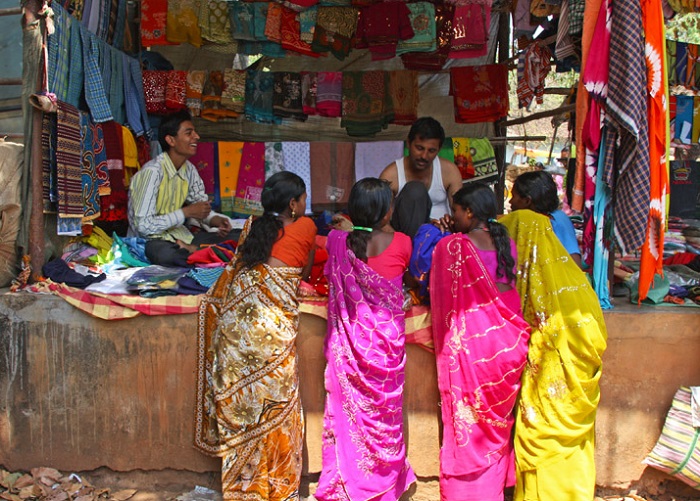
The state hosts many religious sects such as Satnami Panth, Kabirpanth, Ramnami Samaj, and others. Lord Rama along with his wife Sita, has lived in the Bastar region of Chhattisgarh for more than 10 years of their 14 years of exile. The Odia culture is prominent in the eastern parts of Chhattisgarh bordering Odisha.
Hinduism is the main religion while you can find a significant population of Islam and Buddhism. The state follows its own tribal customs and beliefs. Satnami, Kabirpanth, and Ramnami Samaj are few religious sects you can find in the state.
Costume
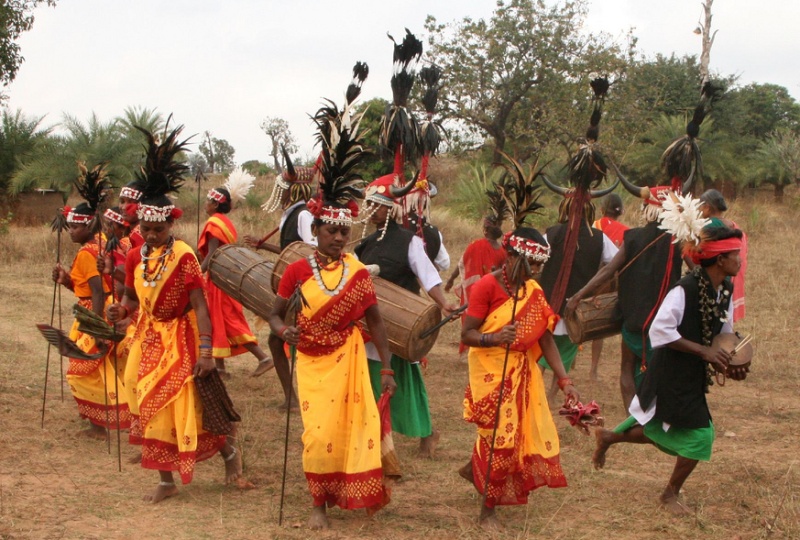
Chhattisgarh has several tribal and ethnic groups, who have their creative and unique take on fabrics, apparels, and their clothing style. The women love to flaunt their tribal designs in their traditional as well as modern wear.
Women of Chhattisgarh wear a sari known as ‘Lugda’ in kachhora style along with the blouse which is known as ‘Polkha’. The saree of women is knee-length or full length. Lugda is made up of linen silk or cotton and their sarees usually are die with vibrant colors. They have loud fabrics, metal jewelry, silver ghunghrus, and wooden bangles which make tribal women more lively and colorful. Tie and Dye is a common technique to make fabrics and is commonly known as Batik. Maheshwari sarees, Chanderi silk sarees, Odisha silk sarees, batik sarees, etc can be seen among tribal women.
Tribal men wear dhotis made of cotton, jute, or linen, with sleeveless jackets and headgear of cotton turbans for protection from harsh sun during the day. The urban areas of Chhattisgarh men prefer shirts and pants, while females wear suits and salwar and sarees.
During their festivals, you can witness their wonderful display of costumes with peacock feathers, bright headgears, chunky ornaments made of wood, metal, etc. Hence the costume of Chhattisgarh is what rural and tribal groups wear making them more rich, beautiful, and inimitable.
Suggested Read: Traditional Dresses Of Indian States
Cuisines

Chhattisgarh is known as “Rice Bowl of India” so rice is heavily consumed in their food. While their staple food includes Wheat, Millets, Rice flour, High Protein Lentils, Bajra, Maize, and Jawar. Their cuisines are influenced by neighboring states.
Chila is a flatbread prepared with the rice and urad dal mixture is an important breakfast menu for people of Chhattisgarh. Iddhar is a traditional dish made with ground Urad dal and kochai patta. People love to eat Baasi here, it is leftover rice dipped in water and curd and eaten with chutney.
The typical Chhattisgarhi thali consists of roti, bhat, dal or kadhi, curry, chutney, and bhaji. Few Chhattisgarhi dishes are Aamat, Bafauri, Bhajia, Chousela, Dubkikadhi, Farra, Khurmi, Moong Bara, Thethari, and Muthia. Among the sweets gulgula (bobra), bidiya, dhoodh fara, bafauli, kusli, balooshahi, singhara, tikhur ,anarsa, and khurmi fall are eaten.
Among the drinks, a brew made of small, creamy white fruit of a local tree known as ‘mahuwa’ is quite popular, and in great demand in the state.
Suggested Read: Famous Food Of Indian States
Fair and Festivals
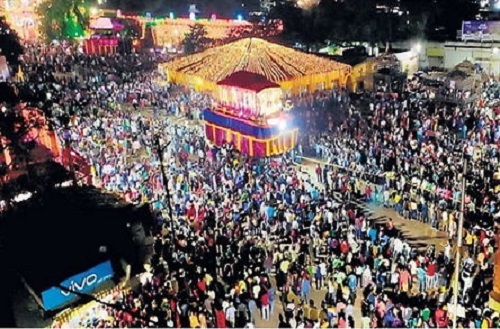
The culture of Chhattisgarh is based on the celebration of some festivals, apart from the main festival like Deepawali Holi, Durga puja they have their own unique tribal celebrations.
The main festivals at Chhattisgarh are Hareli festival, Bhagoria Festival, Bhoramdeo Festival, Fagun Wadai, Pola Festival, and Teeja Festival. Dusshera is the most popular celebration of Chhattisgarh especially Bastar Dusshera. Dusshera in Bastar is entirely not quite the same as the Dusshera of North India. Bastar Dusshera is committed totally to goddess Danteshwari and celebrated with awesome joy by every real tribe of Bastar.
Madai Festival is another well-known celebration of Bastar locale held in the diverse towns stretching out from Mandla to Bastar. Bhagoriya Festival is a well-known celebration among Bhil tribes of the locale and Bhagoradev or the lord of the move is venerated on this event. Kajari Festival is another critical celebration of Chhattisgarh district, which falls around the same time as Raksha Bandhan that is on the Shravan Purnima.
Moreover, there are numerous celebrations in Chhattisgarh, which are identified with farming. Hariyali, Kora, Navakhani, and Cherta Festivals are the most essential rural celebrations of Chhattisgarh.
Besides these festivals there are numerous fairs held in various places of Chhattisgarh like Rajim Lochan Mahotsav, Bhoramdeo Mahotsav, Chakradhar Festival, Goncha Festival, Narayanpur Mela and Sheorinarayan Fair are most delighted fairs of the state.
Dance and Music

Chhattisgarh is an amalgamation of various tribes and each has its own dance forms. Most of the folk dances of Chhattisgarh are performed as a part of rituals in reverence to Gods and changing seasons. Each dance forms have special costumes and accessories and is perfect synchronization which will leave you mesmerized.
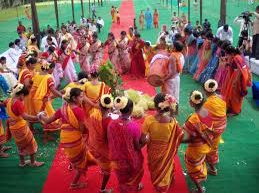
Some of the popular dance forms are Saila Dance which is a stick dance and performed during harvest season. It is famous among the people of Sarguja, Chhindwara, and Baitul districts. Karma is a fold dance performed during the autumnal festival and is performed by tribal groups like Gonds, Baigas, and Oraons. Sua Nacha or Suwa Folk dance is a parrot dance performed during the occasion of Goura Marriage, a month in advance of the festival Diwali. Raut Nacha is celebrated after Diwali and the cowherds of Chhattisgarh are the main artist of the dance. Panthi dance is performed by the Satnami community of Chhattisgarh.
Art and Crafts
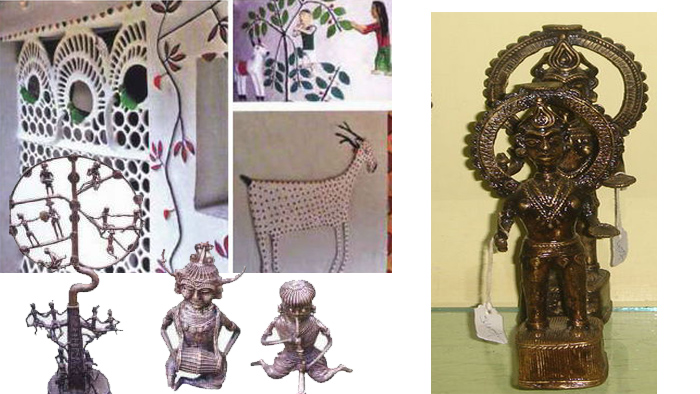
Chhattisgarh is renowned for rich metal crafts and other handicrafts made of bamboo and wood. Folk painting and folk jewelry of Chhattisgarh are very popular. The painting depicts the living style of the tribal people of which Fork Art Painting and Pithora paintings are very popular.
Tribal men and women of Chattisgarh wear traditional folk ornaments made out of beads, which seems quite interesting. Overall, Bamboo work, Woodcarving, Fork Art Paintings, and folk Jewelry are the primary forms of handicrafts in Chattisgarh.
Famous personalities
In Chhattisgarh, there are many famous persons from Chhattisgarh who got fame some of them are – Actor Satyajeet Dubey, Artist Teejan Bai, Business Tycoon Jairam Valjee Chouhan, Movie Director Anurag Basu, Freedom Fighter Dada Dharmadhikari
Tourism

Chhattisgarh land is known for its temples and waterfall, a land known to be heavily forested, a home where Chitrakoot falls are witnessed the best. Chhattisgarh embraces national parks and biosphere reserves, the waterfalls, monuments, wildlife sanctuaries, hills, museums, caves with utmost beauty. The major cities of the state are Raipur, Durg, Bilaspur, Korba, Bhilai, Rajnandgaon.
The state is surrounded by dense forests, hills, streams, waterfalls, natural caves, and parks, etc. Bastar city of Chhattisgarh, known as Kashmir, attracts many foreign tourists. One of the largest rivers of India, Mahanadi has its origin in this state. The Chitrakote Falls also called the Niagra of India.
The state receives many tourists throughout the year. You can see here carved temples, ancient monuments, rare wildlife, caves, Buddha sites, palaces, waterfalls, stone paintings, and mountainous areas. Famous tourist places of Chhattisgarh include Bastar, Kailash, and Kotamsar Caves, Mahamaya Temple.
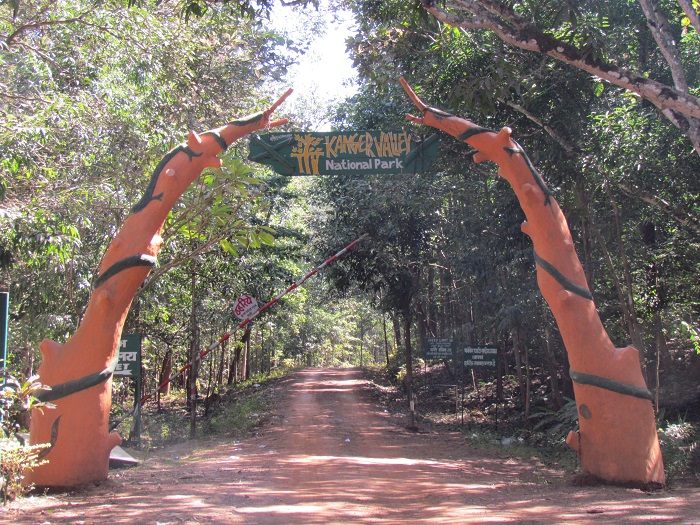
Other famous sites include Achanakmar Wildlife Sanctuary, Udanti Wildlife Sanctuary, Gomarda Reserve Forest, Maitri Tiger, Chitrakote, Chitradhar Waterfall, Tirthgarh Waterfall, Barsoor, Laxman Temple, Uvadaggaram Parshwa Shrine, Mahanti Ghasi Das Memorial Museum, Chaturgarh Fort, Ratanpur Fort, Kankar Palace And etc.
Suggested Read: Formation Dates of Indian States






